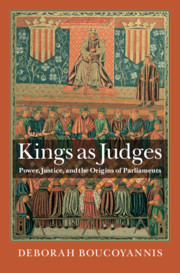Book contents
- Kings as Judges
- Kings as Judges
- Copyright page
- Contents
- Figures
- Tables
- Preface and Acknowledgments
- Part I The Origins of Representative Institutions: Power, Land, and Courts
- Part II The Origins of Representative Practice: Power, Obligation, and Taxation
- Part III Trade, Towns, and the Political Economy of Representation
- Part IV Land, Conditionality, and Property Rights
- 10 Power, Land, and Second-Best Constitutionalism: Central and Northern Europe
- 11 Conditional Land Law, Property Rights, and “Sultanism”: Premodern English and Ottoman Land Regimes
- 12 Land, Tenure, and Assemblies: Russia in the Sixteenth and Seventeenth Centuries
- Part V Why Representation in the West: Petitions, Collective Responsibility, and Supra-Local Organization
- Bibliography
- Index
10 - Power, Land, and Second-Best Constitutionalism: Central and Northern Europe
from Part IV - Land, Conditionality, and Property Rights
Published online by Cambridge University Press: 18 June 2021
- Kings as Judges
- Kings as Judges
- Copyright page
- Contents
- Figures
- Tables
- Preface and Acknowledgments
- Part I The Origins of Representative Institutions: Power, Land, and Courts
- Part II The Origins of Representative Practice: Power, Obligation, and Taxation
- Part III Trade, Towns, and the Political Economy of Representation
- Part IV Land, Conditionality, and Property Rights
- 10 Power, Land, and Second-Best Constitutionalism: Central and Northern Europe
- 11 Conditional Land Law, Property Rights, and “Sultanism”: Premodern English and Ottoman Land Regimes
- 12 Land, Tenure, and Assemblies: Russia in the Sixteenth and Seventeenth Centuries
- Part V Why Representation in the West: Petitions, Collective Responsibility, and Supra-Local Organization
- Bibliography
- Index
Summary
Part IV examines in greater detail a central concept in the preceding chapters: conditionality. Its ubiquity throughout the previous sections raises the question whether it might suffice to explain representation. The question is first approached by examining how conditionality operated in cases where ruler power was weak. Under such conditions, it led to "second-best constitutionalism," a pattern of governance emerging where rulers lacked power over the most powerful and developed conditional relations with groups they endowed with counterbalancing resources. This explains representative governance in cases where the regime was not able to control all social groups: representation was focused on the groups with conditional relations with the crown. This helps explain the cases of Hungary and Poland, which are treated here at greater length, as well as Sweden, Denmark, and the Holy Roman Empire, which are treated more briefly.
Keywords
- Type
- Chapter
- Information
- Kings as JudgesPower, Justice, and the Origins of Parliaments, pp. 207 - 230Publisher: Cambridge University PressPrint publication year: 2021



